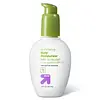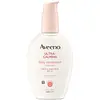What's inside
What's inside
 Key Ingredients
Key Ingredients

 Benefits
Benefits

 Concerns
Concerns

 Ingredients Side-by-side
Ingredients Side-by-side

Octocrylene 75%
UV AbsorberC12-15 Alkyl Benzoate
AntimicrobialGlycerin
HumectantCetearyl Alcohol
EmollientDimethicone
EmollientGlycine Soja Seed Extract
Skin ConditioningTocopherol
AntioxidantPhenyl Trimethicone
Skin ConditioningAloe Barbadensis Leaf Juice
Skin ConditioningArachidyl Alcohol
EmollientCetearyl Glucoside
EmulsifyingPanthenol
Skin ConditioningEthylene/Acrylic Acid Copolymer
Emulsion StabilisingBehenyl Alcohol
EmollientSteareth-2
EmulsifyingSteareth-21
CleansingPolymethyl Methacrylate
Polyacrylamide
Disodium EDTA
C13-14 Isoparaffin
EmollientLaureth-7
EmulsifyingSilica
AbrasivePEG-4 Dilaurate
EmulsifyingPEG-4 Laurate
EmulsifyingPEG-4
HumectantIodopropynyl Butylcarbamate
PreservativeMica
Cosmetic ColorantOctocrylene 75%, C12-15 Alkyl Benzoate, Glycerin, Cetearyl Alcohol, Dimethicone, Glycine Soja Seed Extract, Tocopherol, Phenyl Trimethicone, Aloe Barbadensis Leaf Juice, Arachidyl Alcohol, Cetearyl Glucoside, Panthenol, Ethylene/Acrylic Acid Copolymer, Behenyl Alcohol, Steareth-2, Steareth-21, Polymethyl Methacrylate, Polyacrylamide, Disodium EDTA, C13-14 Isoparaffin, Laureth-7, Silica, PEG-4 Dilaurate, PEG-4 Laurate, PEG-4, Iodopropynyl Butylcarbamate, Mica
Butyl Methoxydibenzoylmethane 3%
UV AbsorberEthylhexyl Methoxycinnamate 7.5%
UV AbsorberEthylhexyl Salicylate 2%
UV AbsorberWater
Skin ConditioningC12-15 Alkyl Benzoate
AntimicrobialCetearyl Alcohol
EmollientDimethicone
EmollientCyclopentasiloxane
EmollientGlycerin
HumectantCyclohexasiloxane
EmollientArachidyl Alcohol
EmollientPhenyl Trimethicone
Skin ConditioningPhenoxyethanol
PreservativeCetearyl Glucoside
EmulsifyingPanthenol
Skin ConditioningBenzyl Alcohol
PerfumingEthylene/Acrylic Acid Copolymer
Emulsion StabilisingChrysanthemum Parthenium Extract
Skin ConditioningBehenyl Alcohol
EmollientSteareth-2
EmulsifyingSodium Cocoyl Amino Acids
CleansingSteareth-21
CleansingParfum
MaskingPolyacrylamide
Arachidyl Glucoside
EmulsifyingDisodium EDTA
Methylparaben
PreservativeC13-14 Isoparaffin
EmollientPentaerythrityl Tetra-Di-T-Butyl Hydroxyhydrocinnamate
AntioxidantSarcosine
Skin ConditioningLaureth-7
EmulsifyingEthylparaben
PreservativeButylparaben
MaskingPropylparaben
PreservativeIsobutylparaben
AntimicrobialIodopropynyl Butylcarbamate
PreservativePotassium Aspartate
Skin ConditioningMagnesium Aspartate
Skin ConditioningButyl Methoxydibenzoylmethane 3%, Ethylhexyl Methoxycinnamate 7.5%, Ethylhexyl Salicylate 2%, Water, C12-15 Alkyl Benzoate, Cetearyl Alcohol, Dimethicone, Cyclopentasiloxane, Glycerin, Cyclohexasiloxane, Arachidyl Alcohol, Phenyl Trimethicone, Phenoxyethanol, Cetearyl Glucoside, Panthenol, Benzyl Alcohol, Ethylene/Acrylic Acid Copolymer, Chrysanthemum Parthenium Extract, Behenyl Alcohol, Steareth-2, Sodium Cocoyl Amino Acids, Steareth-21, Parfum, Polyacrylamide, Arachidyl Glucoside, Disodium EDTA, Methylparaben, C13-14 Isoparaffin, Pentaerythrityl Tetra-Di-T-Butyl Hydroxyhydrocinnamate, Sarcosine, Laureth-7, Ethylparaben, Butylparaben, Propylparaben, Isobutylparaben, Iodopropynyl Butylcarbamate, Potassium Aspartate, Magnesium Aspartate
 Reviews
Reviews

Ingredients Explained
These ingredients are found in both products.
Ingredients higher up in an ingredient list are typically present in a larger amount.
Arachidyl Alcohol is a fatty alcohol made from peanut oil. It is an emollient, emulsifier, and thickener.
You'll most likely find this ingredient as an emulsifier in water-based cosmetics.
Behenyl Alcohol is a type of fatty alcohol (these are different from the drying, solvent alcohols).
Fatty Alcohols have hydrating properties and are most often used as an emollient or to thicken a product. They are usually derived from natural fats and oils; behenyl alcohol is derived from the fats of vegetable oils.
Emollients help keep your skin soft and hydrated by creating a film that traps moisture in.
In 2000, Behenyl Alcohol was approved by the US as medicine to reduce the duration of cold sores.
Learn more about Behenyl AlcoholC12-15 Alkyl Benzoate is made up of Benzoic Acid and long chain alcohols. It has a low molecular weight.
C12-15 Alkyl Benzoate is an emollient and texture enhancer. Due to its solubility, it is often used in sunscreens to help evenly distribute active ingredients.
As an emollient, C12-15 Alkyl Benzoate helps soften and hydrate your skin. Emollients create a film on your skin that traps moisture within.
This ingredient has been reported to cause eye irritation.
Learn more about C12-15 Alkyl BenzoateThis ingredient is also known as "C13-14 Isoalkane".
C13-14 Isoparaffin is created from petroleum-based mineral oils. It is an emollient and helps thicken a product.
As an emollient, it helps keep the skin soft and smooth by creating a barrier on top. This barrier traps moisture in, keeping the skin hydrated.
C13-14 Isoparaffin may not be fungal-acne safe.
Learn more about C13-14 IsoparaffinCetearyl alcohol is a mixture of two fatty alcohols: cetyl alcohol and stearyl alcohol. It is mainly used as an emulsifier. Emulsifiers help prevent the separation of oils and products. Due to its composition, it can also be used to thicken a product or help create foam.
Cetearyl alcohol is an emollient. Emollients help soothe and hydrate the skin by trapping moisture.
Studies show Cetearyl alcohol is non-toxic and non-irritating. The FDA allows products labeled "alcohol-free" to have fatty alcohols.
This ingredient is usually derived from plant oils such as palm, vegetable, or coconut oils. There is debate on whether this ingredient will cause acne.
Due to the fatty acid base, this ingredient may not be Malassezia folliculitis safe.
Learn more about Cetearyl AlcoholCetearyl Glucoside is a surfactant and emulsifier. It can be produced from synthetic of natural sources of cetearyl alcohol and glucose.
Emulsifiers help prevent ingredients from separating, such as oils and waters. It can also be used to enhance the texture of products.
As a surfactant, Cetearyl Glucoside helps during the cleansing process. By gathering all the dirt and oils, it allows these molecules to be washed away easily.
Learn more about Cetearyl GlucosideDimethicone is a type of synthetic silicone created from natural materials such as quartz.
What it does:
Dimethicone comes in different viscosities:
Depending on the viscosity, dimethicone has different properties.
Ingredients lists don't always show which type is used, so we recommend reaching out to the brand if you have questions about the viscosity.
This ingredient is unlikely to cause irritation because it does not get absorbed into skin. However, people with silicone allergies should be careful about using this ingredient.
Note: Dimethicone may contribute to pilling. This is because it is not oil or water soluble, so pilling may occur when layered with products. When mixed with heavy oils in a formula, the outcome is also quite greasy.
Learn more about DimethiconeDisodium EDTA plays a role in making products more stable by aiding other preservatives.
It is a chelating agent, meaning it neutralizes metal ions that may be found in a product.
Disodium EDTA is a salt of edetic acid and is found to be safe in cosmetic ingredients.
Learn more about Disodium EDTAWe don't have a description for Ethylene/Acrylic Acid Copolymer yet.
Glycerin is already naturally found in your skin. It helps moisturize and protect your skin.
A study from 2016 found glycerin to be more effective as a humectant than AHAs and hyaluronic acid.
As a humectant, it helps the skin stay hydrated by pulling moisture to your skin. The low molecular weight of glycerin allows it to pull moisture into the deeper layers of your skin.
Hydrated skin improves your skin barrier; Your skin barrier helps protect against irritants and bacteria.
Glycerin has also been found to have antimicrobial and antiviral properties. Due to these properties, glycerin is often used in wound and burn treatments.
In cosmetics, glycerin is usually derived from plants such as soybean or palm. However, it can also be sourced from animals, such as tallow or animal fat.
This ingredient is organic, colorless, odorless, and non-toxic.
Glycerin is the name for this ingredient in American English. British English uses Glycerol/Glycerine.
Learn more about GlycerinIodopropynyl Butylcarbamate is a preservative.
Laureth-7 is created by the ethoxylation of lauryl alcohol using ethylene oxide. Lauryl alcohol is a fatty alcohol with hydrating properties.
This ingredient is an emulsifier and cleansing ingredient. As an emulsifier, it is used to prevent ingredients from separating. It also helps cleanse the skin by gathering dirt, oil, and pollutants to be rinsed away.
Panthenol is a common ingredient that helps hydrate and soothe the skin. It is found naturally in our skin and hair.
There are two forms of panthenol: D and L.
D-panthenol is also known as dexpanthenol. Most cosmetics use dexpanthenol or a mixture of D and L-panthenol.
Panthenol is famous due to its ability to go deeper into the skin's layers. Using this ingredient has numerous pros (and no cons):
Like hyaluronic acid, panthenol is a humectant. Humectants are able to bind and hold large amounts of water to keep skin hydrated.
This ingredient works well for wound healing. It works by increasing tissue in the wound and helps close open wounds.
Once oxidized, panthenol converts to pantothenic acid. Panthothenic acid is found in all living cells.
This ingredient is also referred to as pro-vitamin B5.
Learn more about PanthenolPhenyl Trimethicone is a silicon-based polymer. It is derived from silica.
Phenyl Trimethicone is used as an emollient and prevents products from foaming.
As an emollient, it helps trap moisture in the skin. It is considered an occlusive.
Learn more about Phenyl TrimethiconePolyacrylamide is a synthetic polymer. It is used to stabilize products and bind ingredients. When hydrated, Polyacrylamide forms a soft gel.
Polyacrylamide is low-toxicity. If source properly, it is deemed safe to use in cosmetics.
It should be noted the precursor to Polyacrylamide is acrylamide. Acrylamide is a carcinogen. Most reputable sources of Polyacrylamide will screen for residual acrylamide to make sure the count is in a safe range. Acrylamide is not able to be absorbed through the skin.
We recommend speaking with a professional if you have concerns.
Learn more about PolyacrylamideSteareth-2 is a waxy compound used to emulsify ingredients. It is created from polyethylene glycol and stearyl alcohol.
The 2 stands for the number of ethylene oxide units used to create this ingredient.
We don't have a description for Steareth-21 yet.